- Home
- Edgar Allan Poe
The Narrative of Arthur Gordon Pym of Nantucket Page 26
The Narrative of Arthur Gordon Pym of Nantucket Read online
Page 26
SQUARE-RIGGED: Ships having chiefly square sails.
STAY: A stay is part of the standing rigging … and is used to support the weight of a mast. It is a large strong rope extending from the upper end of each mast and running down towards the deck of the vessel in a midships fore and aft direction.… TO STAY. To tack, to bring the ship’s head up to the wind for going about … IN STAYS, or HOVE IN STAYS, is the situation of a vessel when she is staying, or in the act of going about.
TOPSAIL SCHOONER: Is full schooner-rigged, but carries a square-topsail on the foremast; the foresail not bent, but set as a square-sail. She may also carry a main-topsail, and is then termed a two-topsail schooner.
WINDWARD: The weather-side; that on which the wind blows; the opposite of LEEWARD.
—Selected definitions from The Sailor’s Word-book, compiled by former admiral William Henry Smyth and published posthumously in London in 1867.
Dinner at Sea
As our fare was novel, and so different from shore living, it was some time before I could get fully reconciled to it: it was composed of hard sea-biscuit, fresh beef while in port, but salt pork and salt beef at sea, pea-soup and burgoo. Burgoo, or, as it was sportively called, skillagallee, was oatmeal boiled in water to the consistency of hasty pudding. Sometimes we had cocoa instead of burgoo. Once a week we had flour and raisins served out, with which we made ‘duff,’ or pudding.
—From William Bligh’s Life of a Sailor-Boy, published in Mutiny of the Bounty and Other Narratives in 1885.
I have seen old sailors, as seasoned, you would have thought, to every possible motion of a ship as their stomachs were to salt junk, as sick as dogs in short cross seas, or when lying roasting and roiling upon a glassy tropical ocean …
We dined, as usual, in our maritime fashion on deck, and this day our dinner was a piece of salt junk, a bit of real beef—not the pickled hunks of mahogany which are shipped for sailors’ eating out of London by the rascally purveyors …
—From W. Clark Russell’s A Sailor’s Sweetheart: An Account of the Wreck of the Sailing Ship, Waldershare, from the Narrative of Mr. William Lee, Second Mate. The two-volume work was published in 1881.
Major F—— is looking well, and all the Officers are as well as can be expected when living on salt junk and a stray fowl now and then.
—From William F. B. Laurie’s Pegu: Being a Narrative of Events During the Second Burmese War, from August 1852 to Its Conclusion in June 1853, published in 1865.
The mermaid tattoo, ca. 1808, comes from a preserved skin specimen. Ira Dye’s “The Tattoos of Early American Seafarers, 1796–1818″ (The American Philosophical Society, 1989) examines the prevalence of tattoos—particularly of the arm and hand—in American sailor populations of the time period. According to Philadelphia records, the most common tattoos were initials, names, and dates. Other popular tattoos, often symbolic, included paired pigs and roosters, thought to protect one from drowning; the words “HOLD FAST” on the knuckles to protect the wearer from falling; and avian tattoos—particularly swallows—to symbolize milestones and other accomplishments.
4. THE WHITENESS
The Hue of the Skin of the Figure
March 22. The darkness had materially increased, relieved only by the glare of the water thrown back from the white curtain before us. Many gigantic and pallidly white birds flew continuously now from beyond the veil, and their scream was the eternal “Tekeli-li!” as they retreated from our vision. Hereupon Nu-Nu stirred in the bottom of the boat; but upon touching him we found his spirit departed. And now we rushed into the embraces of the cataract, where a chasm threw itself open to receive us. But there arose in our pathway a shrouded human figure, very far larger in its proportions than any dweller among men. And the hue of the skin of the figure was of the perfect whiteness of the snow.
—From Pym, Chapter XXV.
The Ice Was All Between
PART I
It is an ancient Mariner,
And he stoppeth one of three.
“By his long grey beard and glittering eye,
Now wherefore stopp’st thou me?
The Bridegroom’s doors are opened wide,
And I am next of kin;
The guests are met, the feast is set:
May’st hear the merry din.”
He holds him with his skinny hand,
“There was a ship,” quoth he.
“Hold off! unhand me, grey-beard loon!”
Eftsoons his hand dropt he.
He holds him with his glittering eye—
The Wedding-Guest stood still,
And listens like a three years’ child:
The Mariner hath his will.
The Wedding-Guest sat on a stone:
He cannot choose but hear;
And thus spake on that ancient man,
The bright-eyed Mariner.
“The ship was cheered, the harbour cleared,
Merrily did we drop
Below the kirk, below the hill,
Below the lighthouse top.
The Sun came up upon the left,
Out of the sea came he!
And he shone bright, and on the right
Went down into the sea.
Higher and higher every day,
Till over the mast at noon—”
The Wedding-Guest here beat his breast,
For he heard the loud bassoon.
The bridge hath paced into the hall,
Red as a rose is she;
Nodding their heads before her goes
The merry minstrelsy.
The Wedding-Guest he beat his breast,
Yet he cannot choose but hear;
And thus spake on that ancient man,
The bright-eyed Mariner.
And now the STORM-BLAST came, and he
Was tyrannous and strong:
He struck with his o’ertaking wings,
And chased us south along.
With sloping masts and dipping prow,
As who pursued with yell and blow
Still treads the shadow of his foe,
And forward bends his head,
The ship drove fast, loud roared the blast,
And southward aye we fled.
And now there came both mist and snow,
And it grew wondrous cold:
And ice, mast-high, came floating by,
As green as emerald.
And through the drifts the snowy clifts
Did send a dismal sheen:
Nor shapes of men nor beasts we ken—
The ice was all between.
The ice was here, the ice was there,
The ice was all around:
It cracked and growled, and roared and howled,
Like noises in a swound!
At length did cross an Albatross:
Through the fog it came;
As if it had been a Christian soul,
We hailed it in God’s name.
It ate the food it ne’er had eat,
And round and round it flew.
The ice did split with a thunder-fit;
The helmsman steered us through!
And a good south wind sprung up behind;
The Albatross did follow,
And every day, for food or play,
Came to the mariners’ hollo!
In mist or cloud, on mast or shroud,
It perched for vespers nine;
Whiles all the night, through fog-smoke white,
Glimmered the white Moon-shine.
“God save thee, ancient Mariner!
From the fiends, that plague thee thus!—
Why look’st thou so?”—With my cross-bow
I shot the ALBATROSS.
—From Samuel Taylor Coleridge’s poem Rime of the Ancient Mariner, first published with poems by William Wordsworth as part of the Lyrical Ballads of 1798, a text that effectively launched Romanticism in English literature. The verses quoted here are from Coleridge’s revised edition of 1834.
The White Whale
What the white whale was to Ahab, has been hinted; what, at times, he was to me, as yet remains unsaid.
Aside from those more obvious considerations touching Moby Dick, which could not but occasionally awaken in any man’s soul some alarm, there was another thought, or rather vague, nameless horror concerning him, which at times by its intensity completely overpowered all the rest; and yet so mystical and well nigh ineffable was it, that I almost despair of putting it in a comprehensible form. It was the whiteness of the whale that above all things appalled me. But how can I hope to explain myself here; and yet, in some dim, random way, explain myself I must, else all these chapters might be naught.
Though in many natural objects, whiteness refiningly enhances beauty, as if imparting some special virtue of its own, as in marbles, japonicas, and pearls; and though various nations have in some way recognised a certain royal preeminence in this hue; even the barbaric, grand old kings of Pegu placing the title “Lord of the White Elephants” above all their other magniloquent ascriptions of dominion; and the modern kings of Siam unfurling the same snow-white quadruped in the royal standard; and the Hanoverian flag bearing the one figure of a snow-white charger; and the great Austrian Empire, Caesarian, heir to overlording Rome, having for the imperial colour the same imperial hue; and though this pre-eminence in it applies to the human race itself, giving the white man ideal mastership over every dusky tribe; and though, besides, all this, whiteness has been even made significant of gladness, for among the Romans a white stone marked a joyful day; and though in other mortal sympathies and symbolizings, this same hue is made the emblem of many touching, noble things—the innocence of brides, the benignity of age; though among the Red Men of America the giving of the white belt of wampum was the deepest pledge of honour; though in many climes, whiteness typifies the majesty of Justice in the ermine of the Judge, and contributes to the daily state of kings and queens drawn by milk-white steeds; though even in the higher mysteries of the most august religions it has been made the symbol of the divine spotlessness and power; by the Persian fire worshippers, the white forked flame being held the holiest on the altar; and in the Greek mythologies, Great Jove himself being made incarnate in a snow-white bull; and though to the noble Iroquois, the midwinter sacrifice of the sacred White Dog was by far the holiest festival of their theology, that spotless, faithful creature being held the purest envoy they could send to the Great Spirit with the annual tidings of their own fidelity; and though directly from the Latin word for white, all Christian priests derive the name of one part of their sacred vesture, the alb or tunic, worn beneath the cassock; and though among the holy pomps of the Romish faith, white is specially employed in the celebration of the Passion of our Lord; though in the Vision of St. John, white robes are given to the redeemed, and the four-and-twenty elders stand clothed in white before the great-white throne, and the Holy One that sitteth there white like wool; yet for all these accumulated associations, with whatever is sweet, and honourable, and sublime, there yet lurks an elusive something in the innermost idea of this hue, which strikes more of panic to the soul than that redness which affrights in blood.
This elusive quality it is, which causes the thought of whiteness, when divorced from more kindly associations, and coupled with any object terrible in itself, to heighten that terror to the furthest bounds. Witness the white bear of the poles, and the white shark of the tropics; what but their smooth, flaky whiteness makes them the transcendent horrors they are? That ghastly whiteness it is which imparts such an abhorrent mildness, even more loathsome than terrific, to the dumb gloating of their aspect. So that not the fierce-fanged tiger in his heraldic coat can so stagger courage as the white-shrouded bear or shark.
As for the white shark, the white gliding ghostliness of repose in that creature, when beheld in his ordinary moods, strangely tallies with the same quality in the Polar quadruped. This peculiarity is most vividly hit by the French in the name they bestow upon that fish. The Romish mass for the dead begins with “Requiem eternam” (eternal rest), whence REQUIEM denominating the mass itself, and any other funeral music. Now, in allusion to the white, silent stillness of death in this shark, and the mild deadliness of his habits, the French call him REQUIN.
Bethink thee of the albatross, whence come those clouds of spiritual wonderment and pale dread, in which that white phantom sails in all imaginations? Not Coleridge first threw that spell; but God’s great, unflattering laureate, Nature.
I assert, then, that in the wondrous bodily whiteness of the bird chiefly lurks the secret of the spell …
But thou sayest, methinks that white-lead chapter about whiteness is but a white flag hung out from a craven soul; thou surrenderest to a hypo, Ishmael.
Tell me, why this strong young colt, foaled in some peaceful valley of Vermont, far removed from all beasts of prey—why is it that upon the sunniest day, if you but shake a fresh buffalo robe behind him, so that he cannot even see it, but only smells its wild animal muskiness—why will he start, snort, and with bursting eyes paw the ground in phrensies of affright? There is no remembrance in him of any gorings of wild creatures in his green northern home, so that the strange muskiness he smells cannot recall to him anything associated with the experience of former perils; for what knows he, this New England colt, of the black bisons of distant Oregon?
No; but here thou beholdest even in a dumb brute, the instinct of the knowledge of the demonism in the world. Though thousands of miles from Oregon, still when he smells that savage musk, the rending, goring bison herds are as present as to the deserted wild foal of the prairies, which this instant they may be trampling into dust.
Thus, then, the muffled rollings of a milky sea; the bleak rustlings of the festooned frosts of mountains; the desolate shiftings of the windrowed snows of prairies; all these, to Ishmael, are as the shaking of that buffalo robe to the frightened colt!
Though neither knows where lie the nameless things of which the mystic sign gives forth such hints; yet with me, as with the colt, somewhere those things must exist. Though in many of its aspects this visible world seems formed in love, the invisible spheres were formed in fright.
But not yet have we solved the incantation of this whiteness, and learned why it appeals with such power to the soul; and more strange and far more portentous—why, as we have seen, it is at once the most meaning symbol of spiritual things, nay, the very veil of the Christian’s Deity; and yet should be as it is, the intensifying agent in things the most appalling to mankind.
Is it that by its indefiniteness it shadows forth the heartless voids and immensities of the universe, and thus stabs us from behind with the thought of annihilation, when beholding the white depths of the milky way? Or is it, that as in essence whiteness is not so much a colour as the visible absence of colour; and at the same time the concrete of all colours; is it for these reasons that there is such a dumb blankness, full of meaning, in a wide landscape of snows—a colourless, all-colour of atheism from which we shrink? And when we consider that other theory of the natural philosophers, that all other earthly hues—every stately or lovely emblazoning—the sweet tinges of sunset skies and woods; yea, and the gilded velvets of butterflies, and the butterfly cheeks of young girls; all these are but subtile deceits, not actually inherent in substances, but only laid on from without; so that all deified Nature absolutely paints like the harlot, whose allurements cover nothing but the charnel-house within; and when we proceed further, and consider that the mystical cosmetic which produces every one of her hues, the great principle of light, for ever remains white or colourless in itself, and if operating without medium upon matter, would touch all objects, even tulips and roses, with its own blank tinge—pondering all this, the palsied universe lies before us a leper; and like wilful travellers in Lapland, who refuse to wear coloured and colouring glasses upon their eyes, so the wretched infidel gazes himself blind at the monumental white shroud that wraps all the prospect around him. And
of all these things the Albino whale was the symbol. Wonder ye then at the fiery hunt?
—From Moby-Dick; or, The Whale, published in 1851 by Herman Melville.
The Iceberg
Saturday, July 2d. This day the sun rose fair, but it ran too low in the heavens to give any heat, or thaw out our sails and rigging; yet the sight of it was pleasant; and we had a steady “reef-topsail breeze” from the westward. The atmosphere, which had previously been clear and cold, for the last few hours grew damp, and had a disagreeable, wet chilliness in it; and the man who came from the wheel said he heard the captain tell “the passenger” that the thermometer had fallen several degrees since morning, which he could not account for in any other way than by supposing that there must be ice near us; though such a thing was rarely heard of in this latitude at this season of the year. At twelve o’clock we went below, and had just got through dinner, when the cook put his head down the scuttle and told us to come on deck and see the finest sight that we had ever seen. “Where away, Doctor?” asked the first man who was up. “On the larboard bow.” And there lay, floating in the ocean, several miles off, an immense, irregular mass, its top and points covered with snow, and its centre of a deep indigo color. This was an iceberg, and of the largest size, as one of our men said who had been in the Northern Ocean. As far as the eye could reach, the sea in every direction was of a deep blue color, the waves running high and fresh, and sparkling in the light, and in the midst lay this immense mountain-island, its cavities and valleys thrown into deep shade, and its points and pinnacles glittering in the sun. All hands were soon on deck, looking at it, and admiring in various ways its beauty and grandeur. But no description can give any idea of the strangeness, splendor, and, really, the sublimity, of the sight. Its great size,—for it must have been from two to three miles in circumference, and several hundred feet in height,—its slow motion, as its base rose and sank in the water, and its high points nodded against the clouds; the dashing of the waves upon it, which, breaking high with foam, lined its base with a white crust; and the thundering sound of the cracking of the mass, and the breaking and tumbling down of huge pieces; together with its nearness and approach, which added a slight element of fear,—all combined to give to it the character of true sublimity. The main body of the mass was, as I have said, of an indigo color, its base crusted with frozen foam; and as it grew thin and transparent toward the edges and top, its color shaded off from a deep blue to the whiteness of snow. It seemed to be drifting slowly toward the north, so that we kept away and avoided it. It was in sight all the afternoon; and when we got to leeward of it the wind died away, so that we lay- to quite near it for a greater part of the night. Unfortunately, there was no moon, but it was a clear night, and we could plainly mark the long, regular heaving of the stupendous mass, as its edges moved slowly against the stars, now revealing them, and now shutting them in. Several times in our watch loud cracks were heard, which sounded as though they must have run through the whole length of the iceberg, and several pieces fell down with a thundering crash, plunging heavily into the sea. Toward morning a strong breeze sprang up, and we filled away, and left it astern, and at daylight it was out of sight.

 The Works of Edgar Allan Poe — Volume 2
The Works of Edgar Allan Poe — Volume 2 The Works of Edgar Allan Poe — Volume 1
The Works of Edgar Allan Poe — Volume 1 The Works of Edgar Allan Poe — Volume 3
The Works of Edgar Allan Poe — Volume 3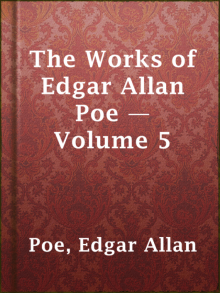 The Works of Edgar Allan Poe — Volume 5
The Works of Edgar Allan Poe — Volume 5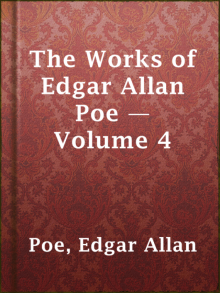 The Works of Edgar Allan Poe — Volume 4
The Works of Edgar Allan Poe — Volume 4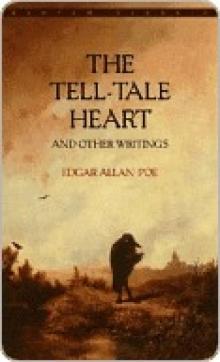 The Tell-Tale Heart
The Tell-Tale Heart The Raven (Penguin)
The Raven (Penguin)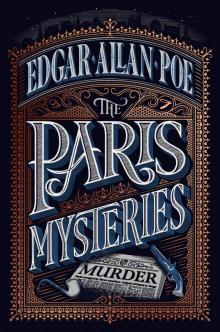 The Paris Mysteries
The Paris Mysteries Tales of Terror from Edgar Allan Poe
Tales of Terror from Edgar Allan Poe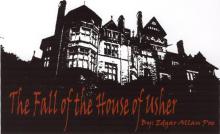 The Fall of the House of Usher
The Fall of the House of Usher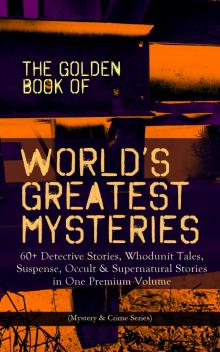 The Golden Book of World's Greatest Mysteries
The Golden Book of World's Greatest Mysteries The Narrative of Arthur Gordon Pym of Nantucket
The Narrative of Arthur Gordon Pym of Nantucket Ligeia
Ligeia The Landscape Garden
The Landscape Garden Complete Tales & Poems
Complete Tales & Poems Great Tales and Poems of Edgar Allan Poe
Great Tales and Poems of Edgar Allan Poe The Colloquy of Monos and Una
The Colloquy of Monos and Una The Oblong Box
The Oblong Box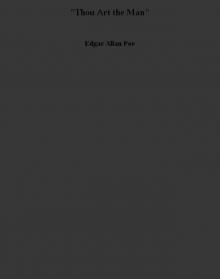 Thou Art the Man
Thou Art the Man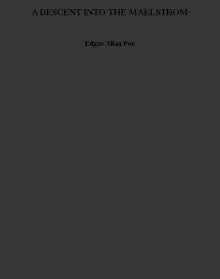 A DESCENT INTO THE MAELSTROM
A DESCENT INTO THE MAELSTROM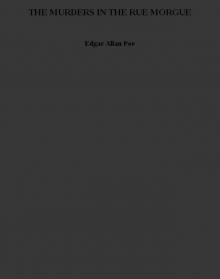 THE MURDERS IN THE RUE MORGUE
THE MURDERS IN THE RUE MORGUE The Business Man
The Business Man The Mystery of Marie Rogêt
The Mystery of Marie Rogêt Metzengerstein
Metzengerstein The Man That Was Used Up
The Man That Was Used Up William Wilson
William Wilson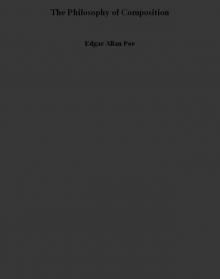 The Philosophy of Composition
The Philosophy of Composition The Portable Edgar Allan Poe
The Portable Edgar Allan Poe Bon-Bon
Bon-Bon A Predicament
A Predicament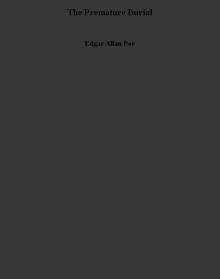 The Premature Burial
The Premature Burial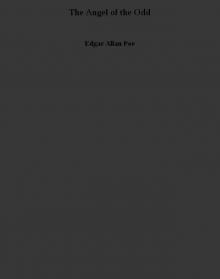 The Angel of the Odd
The Angel of the Odd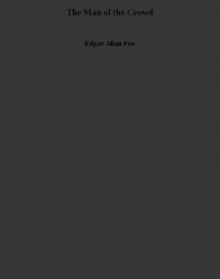 The Man of the Crowd
The Man of the Crowd Never Bet the Devil Your Head
Never Bet the Devil Your Head The Tell-Tale Heart and Other Writings
The Tell-Tale Heart and Other Writings The System of Doctor Tarr and Professor Fether
The System of Doctor Tarr and Professor Fether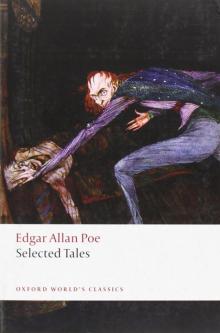 Selected Tales (Oxford World's Classics)
Selected Tales (Oxford World's Classics) Essential Tales and Poems of Edgar Allan Poe (Barnes & Noble Classics Series)
Essential Tales and Poems of Edgar Allan Poe (Barnes & Noble Classics Series) MS. Found in a Bottle
MS. Found in a Bottle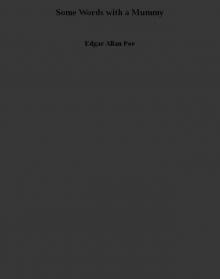 Some Words with a Mummy
Some Words with a Mummy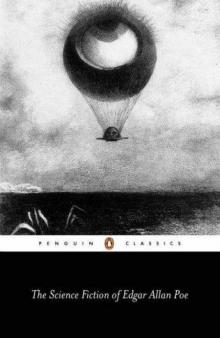 The Science Fiction of Edgar Allan Poe (Penguin Classics)
The Science Fiction of Edgar Allan Poe (Penguin Classics) King Pest
King Pest CRITICISM
CRITICISM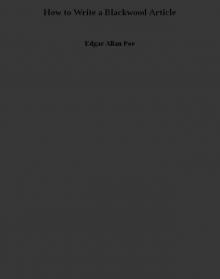 How to Write a Blackwood Article
How to Write a Blackwood Article Mystification
Mystification Diddling Considered as One of the Exact Sciences
Diddling Considered as One of the Exact Sciences Steampunk Poe
Steampunk Poe The Literary Life of Thingum Bob, Esq.
The Literary Life of Thingum Bob, Esq.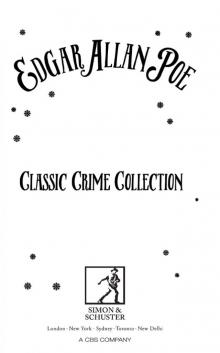 Classic Crime Collection
Classic Crime Collection Complete Stories and Poems of Edgar Allen Poe
Complete Stories and Poems of Edgar Allen Poe Berenice
Berenice The Black Cat
The Black Cat The Slender Poe Anthology
The Slender Poe Anthology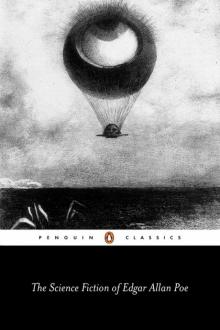 The Science Fiction of Edgar Allan Poe
The Science Fiction of Edgar Allan Poe The Assignation
The Assignation The Thousand-and-Second Tale of Scheherazade
The Thousand-and-Second Tale of Scheherazade The Raven and Other Short Stories
The Raven and Other Short Stories The Spectacles
The Spectacles Hop-Frog
Hop-Frog The Purloined Letter
The Purloined Letter Mellonta Tauta
Mellonta Tauta The Balloon-Hoax
The Balloon-Hoax Landor's Cottage
Landor's Cottage Mesmeric Revelation
Mesmeric Revelation The Pit and the Pendulum
The Pit and the Pendulum